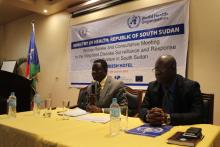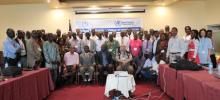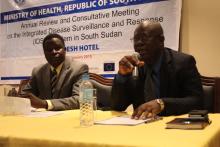WHO Supports Ministry of Health to Host IDSR Review and Consultative Meeting
WHO supported the Ministry of Health to conduct a review meeting on Integrated Disease Surveillance and Response (IDSR) in South Sudan from 27 to 28 January 2015.
Addressing delegates at the meeting, WHO Representative to South Sudan Dr. Tarande Constant Manzila commended the Ministry of Health’s commitment to prioritize the implementation and strengthening of communicable disease surveillance through the adoption and implementation of the IDSR strategy at all levels.
“The high communicable diseases burden in sub-Saharan African countries like South Sudan demands timely response interventions that include designing, developing and implementing efficient, flexible and comprehensive systems that integrate technical staff, resources, and information systems for effective infectious disease surveillance and response,” he said.
The event was attended by surveillance officers from all 10 states and sought to review the progress and achievements of communicable disease surveillance in South Sudan during 2014, with a view to improving in 2015.
“At the end of this meeting we expect to have an annual work plan for each state according to the IDSR strategy we have in place,” said the Director General for Preventive Health Services in the Ministry of Health, Dr. John Rumunu.
Strengthening national disease surveillance, response and control systems involves reinforcing the performance of the health systems, building the skills and competencies of implementers, improving the exchange and dissemination of relevant good quality information, and ensuring accessibility to the information derived from the system. This is essential for South Sudan in order to prevent repeated occurrences of major outbreaks and eradicate diseases like Polio and Guinea Worm.
Implementation of the IDSR strategy in South Sudan has made tangible progress since 2007 and has reached 100% of the counties in all 10 states. Further, health facilities reporting to the central level through weekly IDSR reporting increased to over 50% in the first quarter of 2014 compared to the same period in 2013. This represents a drastic improvement from the baseline reporting rates of less than 30%. However, more effort is required to attain the national target of an 80% reporting rate.
"Our target is to have 80% timely reporting," Dr. Rumunu said.
Reports from member states in the region show that investment in mobile health (mHealth) and electronic surveillance (eSurveillance) applications is a sure way to improve reporting rates, which should be considered for South Sudan.
Due to the improved skills and capacity of surveillance officers at central, state and county level, the number of outbreak rumors reported and investigated within 72 hours in 2014 increased to 70%.
Reliable surveillance depends on good laboratory services, while laboratory capacity and facilities are absolutely essential. The Ministry of Health has taken steps to complete the rehabilitation of the reference laboratory in Juba and procure equipment with the support of WHO, the Global Fund and other agencies. The National Reference Laboratory started conducting culture and sensitivity testing for cholera during the 2014 cholera outbreak. Measles testing continues in the same laboratory, albeit with a few challenges.
The IDSR strategy is designed to help strengthen the capacity of communicable surveillance and respond in an effective manner to threats of emerging infectious diseases within the country. It also promotes early recognition, containment and prevention of domestic and international spread of epidemic outbreaks through networking, information and experience sharing, and the establishment or strengthening of mechanisms to respond to common outbreaks.
WHO pledged to continue supporting the Ministry of Health with various elements of IDSR, including the development and dissemination of disease surveillance guidelines and case definitions; regular IDSR trainings to improve core capacities for surveillance and response at all levels; regular support supervision visits to the states, counties and health facilities; implementation of the Ebola Virus Disease (EVD) preparedness and response plan developed in 2014; disease surveillance and reporting in conflict-affected states; revision of the IDSR strategy and reviewing all essential guidelines in 2015 to ensure all surveillance guidelines and tools are up-to-date; and enhancing the national laboratory until full capacity is established to test all the IDSR national priority diseases.
At the end of the meeting, the delegates committed to double efforts towards enhancing capacities for disease surveillance and response through regular support to health facilities to support their weekly reports on time. This would be coupled with training to reinforce capacity for reporting, data analysis, outbreak investigation and Ebola virus case detection and response. Weekly submission of outbreak event logs and regular supportive supervision at all levels would also take place. An assessment and a pilot to inform the introduction of mobileHealth (mHealth) reporting in South Sudan would also be conducted.
Both the Ministry of Health and WHO expressed gratitude to USAID, ECHO and other donors for their commitment in supporting communicable disease surveillance in South Sudan. WHO will continue to provide the required technical support to strengthen the core capacity of IDSR functions.
__________________________________________
1. Dr. John Rumunu, Director General for Preventive Health Services in the Ministry of Health (left) addressing the meeting.
2. Some of the delegates who attended the IDSR review and consultative meetin.
3. WHO Representative to South Sudan, Dr. Tarande Constant Manzila, addressing delegates at the recently ended IDSR review and consultative meeting.
4. WHO South Sudan Medical Officer for Disease Prevention and Control, Dr. Abdinasir Abubakar addressing delegates at the IDSR review and consultative meeting.
Photo. WHO/M.Moyo.







